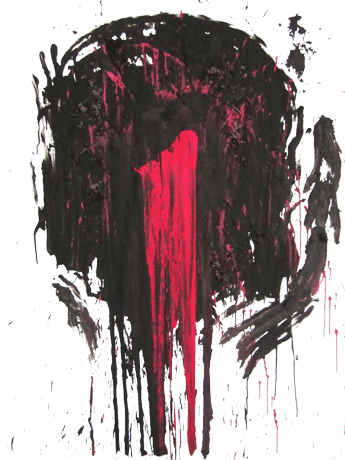Art Therapy
In art therapy we use a practical tool to explore the unconscious.We use paint, crayons, clay, movement, roleplaying and play with the intention to discover or re-discover those parts in the psyche that lies outside our ordinary consciousness.
One of the characteristics for art therapy is that change starts from within the individual when freedom to express is available.
Following the creative expression is a dialogoue that is both imaginative as well as personal leading to new insight.
This describes the two feet in art therapy. One is expressive and outgoing, while the other is imaginative and verbal.


The special thing about the art therapy process is, that it some times goes its own way leading to new places that we could not predict or rationalize using words. The interplay between what we allready know and the archetypal part of psyche is an important aspect of therapeutic change.
We use imagination as a tool to explore the images discovered in the artwork. That means, that we try to avoid reductive interpretation of the artwork but instead create a dilogue with the figures together with the client.
The connection between theory and practise in art therapy is important and necessary if we shall come to explain how and why art therapy heals. Theoretical models are used after the therapeutic process as a tool to organize and communicate experiences from the therapeutic situation.
The understanding of the timing in use of theory is important so that theory does not prevent the art therapy process to unfold from the body. The creative process is understood as self-regulative.
The theoretical foundation at the Institute of Art Therapy in DK is based on a Jungian theoretical foundation. Other theoretical systems are included in the training, and the approach is integrative.
Methods
Art therapy
The art theraputic process contains several phases. First the expressive creative phase, then an imaginative exploration of the artwork, and then a dialogue related to the personal life and existence.
All three phases are considered of equal importance related to therapeutic change.
During the art therapy dialogue memories from life can be activated and integrated in consciousness through the images.
Images then functions as a therapeutic guide that can deepen the self understanding in ways not possible through verbal interaction alone.

Body therapy
Therapeutic change builds on an interplay between head and body and between the consciousness mind and the unconscious.
Therefore an activation of the body is also a possibility to know of content in the unconscious. The bodily aspect in art therapy is very central and is part of any creative process no matter which media is used, because the body is physically a part of the expressive process.
In body therapy the image can be included and understood as a body awareness linked to the emotional memory system that are stored in the body.
The interplay between body movements and images also create a space where it becomes possible to move between the inside and the outside thereby bringing theraputic change further.

Music therapy
In music therapy the body works as a container and as a ressonance for vocal expression used as a way to discover inner life.
By using the voice or different musical instruments early and present relations are explored.
One of the advantages in music therapy is, that sounds can activate memories that lie before language.
Early memories can then be activated and expressed in images, which can deepen psychological integration through the imaginative and personal dialogue.
Psychodrama
In psychodrama the inner life is manifested though roleplaying where other group members play out different roles for the person who is working with a theme.
Central in psychodrama is, that an inner problem is externalized and then becomes more easy to adress in details.
Often a theme is related to its cultural connection where other group members can recognize parts from their own lives in the drama that is played out.
Philosophy

The Jungian approach is used with the intention of reconnecting the conscious mind with the unconscious self in order to find inner guidance from this relationship.
One of Jung’s most important discoveries was that he found a self-regulating force connected to the inner self. That means that the psyche will tend to react on any unbalances we might have in our lives in order to re-create balance. We may become ill or depressed and looses our free will to act in life. Jung considered such reactions as signs and not symptoms and thought, that we needed to understand the meaning of the sign in order to heal ourselves.
The basic understanding of the human potential in Jung’s psychology is connected to the concept of the self. The self is the center in the archetypal psyche and has the ability to regulate the system but is also oriented towards wholeness and the meaning of life. It is considered to be an intentive force with a will stronger that the personal ego consciousness and the most important purpose in psychotherapy is to be in connection and dialogue with the self through out life.
In art therapy the work with images and symbols can form the bridge between the ego and the self through the use of imagination.
In Jungian psychology the trust in the unconscious is the healing attitude. Learning to trust the unconcious as an inner guiding principle is part of the purpose with the imaginative dialogue using images.
At the Institute for art therapy the therapeutic and teaching approach rests on the experience, that a connection to the inner self can improve quality of life for the individual.
